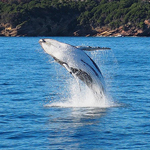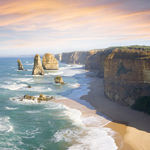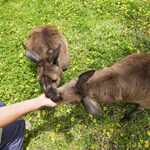Updated on: December 5, 2023
People tend to have two reactions when it comes to Australian animals.
Either their faces light up at the thought of cute kangaroos and koalas, or they actually recoil in horror.
Though several Australian animals are considered dangerous, you’re more likely to get injured from a horse than a snake in Australia.
Over 80% of mammals and reptiles in Australia are found nowhere else on Earth. This makes for some truly fascinating creatures, some famous and others not as well known, to discover in Australia.
Here are 11 unique Australian animals, including some you may not know exist!
Koalas

No one can resist the cuddly allure of koalas. These iconic Australia animals are marsupials, a kind of mammal that is born undeveloped and is carried in a pouch.
Like all marsupials, including kangaroos, wombats and Tasmanian devils, baby koalas are called joeys.
Newborn koalas are called pinkies, born blind and about the size of a jellybean. After birth the pinkie immediately crawls into its mother’s pouch, where it’ll stay for 6 to 7 months.
At around 9 to 10 months the joey leaves the pouch for good, ready to munch on a variety of eucalypts. The leaves of these trees are highly toxic and low on nutrition, requiring lots of energy to digest.
This is why koalas spend so much time snoozing so as to preserve energy – often sleeping up to 18-20 hours a day!
What sets the koala apart from other marsupials is that it has no tail. Nonetheless, koalas live high among eucalypts with ease.
They mostly hang about in tall eucalypt forests and woodlands of Queensland, New South Wales, Victoria and South Australia.

Contrary to popular belief, the koala is not a bear – though it’s certainly as cute as a teddy bear. Their cuddly exterior makes them appear docicle, and though koalas usually keep to themselves, they can attack if they feel threatened.
If spotted in the wild, it’s best to keep a distance.
Where to See Koalas
One of the best places to see koalas in the wild is Kangaroo Island, a natural island sanctuary home to many of Australia’s native animals.
This island off the coast of South Australia is surrounded in stunning bays, untouched wilderness and free roaming wildlife, including koalas.
It’s the ultimate Australia bucket list destination for animal lovers, and one we love to include in our clients’ Australia trip packages.
In the state of Queensland, sanctuaries and zoos allow you to hold koalas, so if you’re after that once-in-a-lifetime snapshot with a koala, be sure to do it in Queensland! It’s illegal to hold koalas anywhere else.
Kangaroos
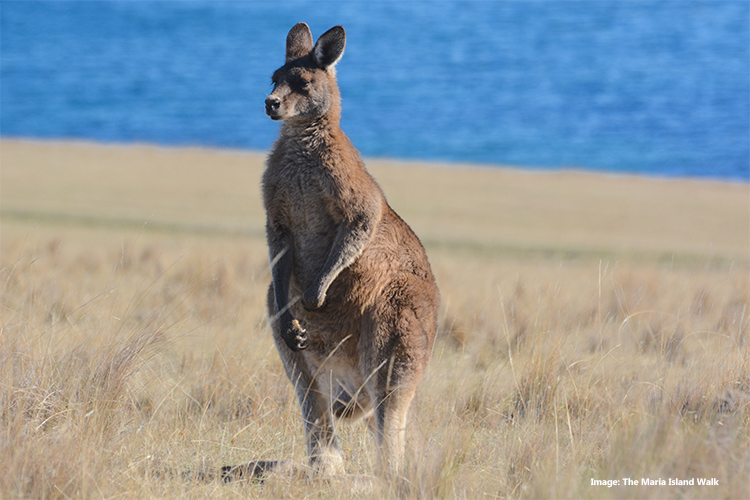
Tell anyone you’re going to Australia and one of the first things they’ll ask is if you’re going to feed the kangaroos. And you’ll most likely answer “Yes!”
These native Australian animals are marsupials as well as macropods, meaning “big foot.”
Red kangaroos, tall and strongly built, are the largest marsupials and the largest Australian mammal, sometimes standing at over 6 feet tall.
Other types of kangaroos include the eastern gray and Kangaroo Island kangaroos, both smaller and tamer than red kangaroos. Gray kangaroos live in the forests of Australia and Tasmania while red kangaroos are found in the eucalyptus woodlands of the Northern Territory.
An old legend about the origin of the name “kangaroo” states that when James Cook asked Aboriginals what these creatures were called, they answered “kangaroo” meaning “I don’t understand your question.”
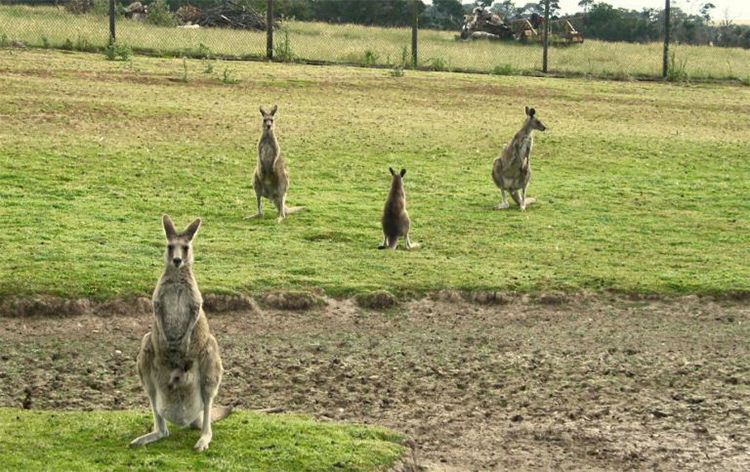
Though this tale has been proven false, who can resist a good origin story?
Recent linguistic studies uncovered the word “gangurru” from the Aboriginal language of Guugu Yimidhirr, referring to a species of kangaroo and is very likely the source of its name.
Male kangaroos can be very aggressive toward each other, fighting over mates, but kangaroos generally keep to themselves and hop away on sight of a human.
With powerful hind legs and a strong tail used as a sort of third leg for balancing, these creatures pack incredible kicks. They’re easily nature’s most skilled kick boxers.
Where to See Kangaroos
You’ll find kangaroos in nearly all Australian wildlife sanctuaries and zoos, but seeing them in the wild is a real special treat.
You’re very likely to see them roaming throughout forested national parks with beaches, as well as along the side of the road on the outskirts of major cities. The best time to spot kangaroos in the wild is at dusk.
Wallabies
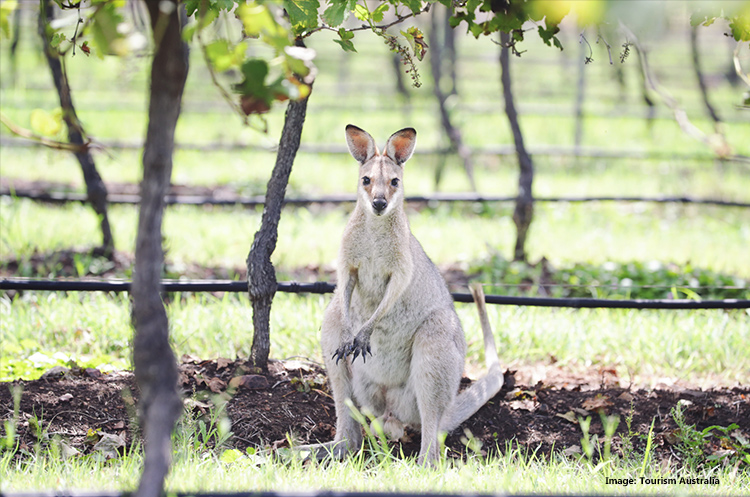
We’ll admit it – it’s kind of hard to tell wallabies and kangaroos apart. But it gets pretty easy once you see them side by side.
Wallabies are almost an exact miniature of kangaroos.
Though they can measure up to 6 feet in height from head to tail, wallabies tend to be much smaller than kangaroos, which can reach up to 8 feet in height from head to tail.
Another way to tell wallabies and kangaroos apart is from their hind legs. Wallabies have more compact legs for moving through dense forest areas while kangaroos have knees and feet set wide apart.
Though smaller, their legs allow for tremendous kicks when threatened and are also great for hopping at high speeds.
They also tend to be more colorful than their larger cousins, with the yellow-footed wallaby boasting yellow-orange features across its coat.
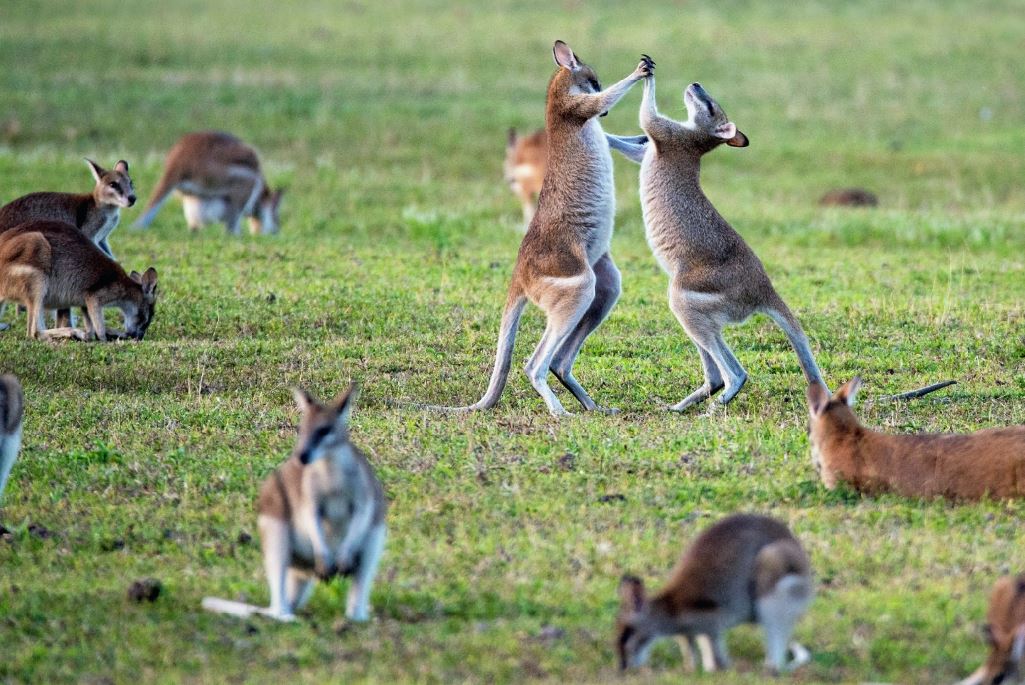
There are roughly 30 different species of wallabies, grouped by their habitat: shrub wallabies, brush wallabies, and rock wallabies. Larger wallabies tend to be social animals, traveling in groups called mobs.
As herbivores, wallabies mainly feast on grasses and plants including flowers, ferns and moss.
Wallabies as a whole are not an endangered species, but there are some species of rock wallabies as well as the banded-hare wallaby that are endangered.
Where to See Wallabies
You’re very likely to see wallabies bounding along the roads in the outskirts of major Australia cities. Locals even report wallabies hanging around gardens and backyards.
You’re even likely to see them lying between grapevines of vineyards throughout the Hunter Valley in New South Wales.
Wildlife parks and zoos are the best spots for seeing wallabies, as these nimble creatures usually dash away at the sight of humans.
Tasmanian Devils
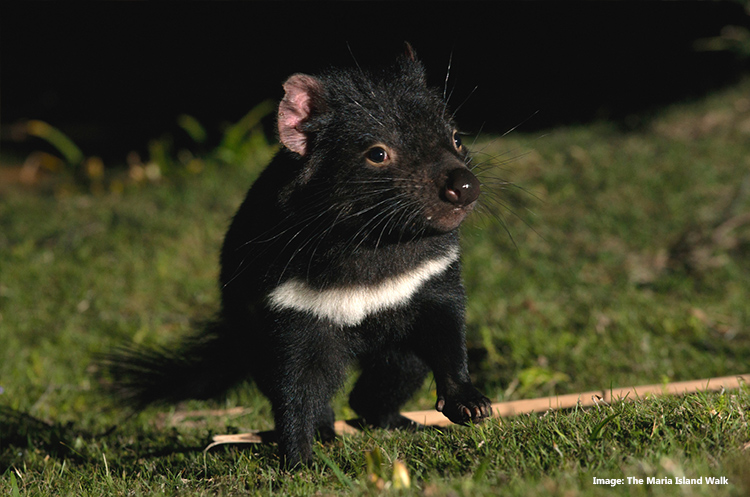
When early European settlers posted in Hobart, Tasmania, they came across a strange creature with frightening growls, high-pitched screeches and unearthly screams.
Coupled with red ears and disturbingly wide jaws lined with sharp teeth, the settlers decided to call these creatures “devils.”
This is how the Tasmanian devil got it’s name, though it may just be the cutest devil ever to grace Australia.
These small creatures almost look like a cross between a small dog and a bear. Their coarse dark fur and round ears give them a baby bear-like appearance, complete with a pudgy build.
With a pouch to carry their young, a mother devils can nurse up to four devils at a time.
As the world’s largest surviving carnivorous marsupial, they tend to eat carrion more than hunting live prey.
Small native animals such as wallabies, wombats and possums are favorites, though they’ll also devour reptiles, birds and even sheep.
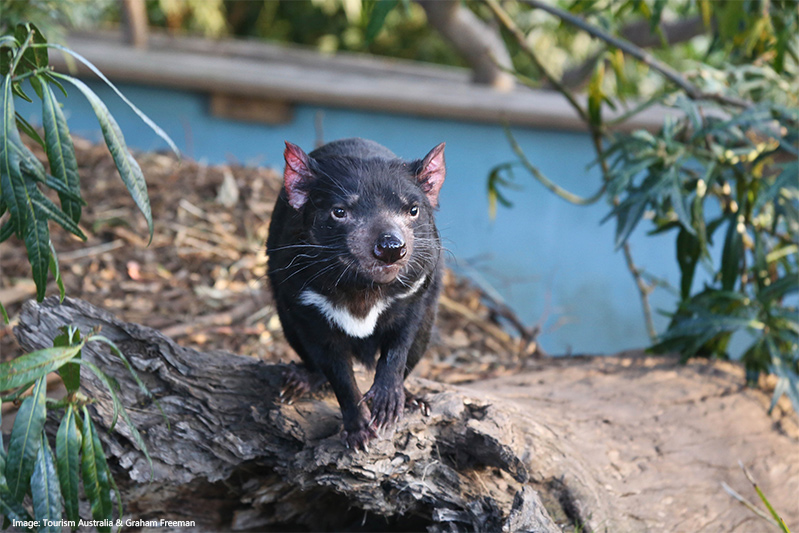
Though nocturnal, devils like to lay out and bask in the sun. They’re huge water lovers, wading and splashing about, even just sitting and laying in water to keep cool.
Even devils can’t resist a lazy sunbathing day.
Once present in mainland Australia, Tasmanian devils are now only found on the island state of Tasmania.
Loss of habitat and more recently Devil Facial Tumor Disease are the leading causes of declining numbers of devils, now listed as endangered.
Though there are huge efforts to minimize the impact of this disease, it’s a difficult task, as this disease is highly contagious among devils.
For these brash creatures that often fight over mates, a simple touch is all it takes for the disease to take hold.
Where to See Tasmanian Devils
Though it’s rare to see devils in the wild, you’re more likely to come across them in maintained wilderness refuges and wildlife parks.
Some of our favorite places to see devils are the Tasmanian Devil Unzoo in northeastern Tasmania and Bonorong Wildlife Sanctuary just half an hour outside of Hobart.
Wombats

These stout marsupials look like miniature bears with chunky cheeks. They grow up to 3 feet long and can weigh between 44 and 77 pounds.
Their waddling walk and pudgy appearance make them seem slow and docile, but they can run up to 25 miles per hour. As highly territorial creatures, they attack when defending their territory.
These nocturnal animals dwell in burrows dug with their long claws.
Like all marsupials, wombats possess a pouch where their young are nurtured for the first few months of life.
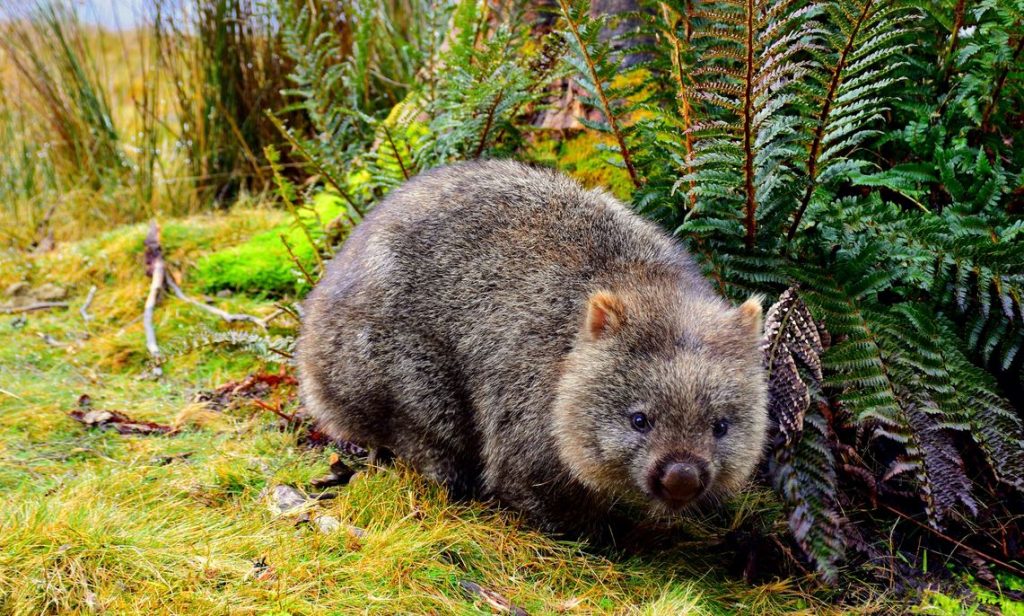
Unlike most other marsupials, however, the wombat’s pouch faces backwards toward its rear.
This is to prevent soil from getting into the pouch as the wombat burrows.
But this strange feature is nothing compared to its poo.
Molded by the horizontal ridges of its large intestine, wombat poo is notorious for its cube shape.
In this way, the wombat’s cube-shaped poo allows it to stay in place and mark its territory.
Where to see Wombats
You’re most likely to see wombats roaming Cradle Mountain in Tasmania and the Blue Mountains outside of Sydney, but it’s rare to see them out in the wild as they are nocturnal creatures.
You’ll definitely find them in wildlife parks and zoos, with some offering the opportunity to pet and feed them.
Dingoes
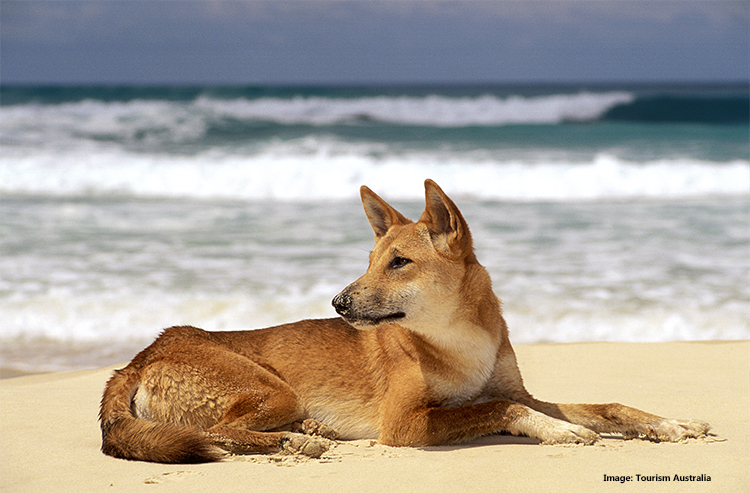
As cute as a dog yet severely misunderstood, the dingo is one of Australia’s most controversial animals.
The origin of these creatures is much debated, with recent studies suggesting that dingoes originally migrated from central Asia across land bridges over 18,000 years ago.
Intensely intuitive and intelligent, Houdini has nothing on dingoes. With incredible agility, flexible joints, rotating wrists and fantastic jumping, digging and climbing abilities, dingoes are the ultimate escape artists.
They can even rotate their necks up to 180 degrees around.
Imagine seeing your dog do that!
Though they share many characteristics with dogs, dingoes are decidedly not dogs at all. They are classed as a unique species called Canis dingo.

Highly individualistic and naturally cautious, dingoes are very curious but are more likely to avoid unfamiliar threats and confrontation.
They tend to shy away from humans, rarely showing aggression or attacking.
Although rarely kept as pets, it is legal in the states of New South Wales, Northern Territory, Victoria and Western Australia to keep a pet dingo with a license.
But doing so is not a light task – dingoes require large amounts of space, lots of bonding, and extensive training.
Where to see Dingoes
Most zoos and wildlife parks house dingoes, but if your heart is set on seeing them in the wild, head to Fraser Island off the coast of Queensland.
Quokkas
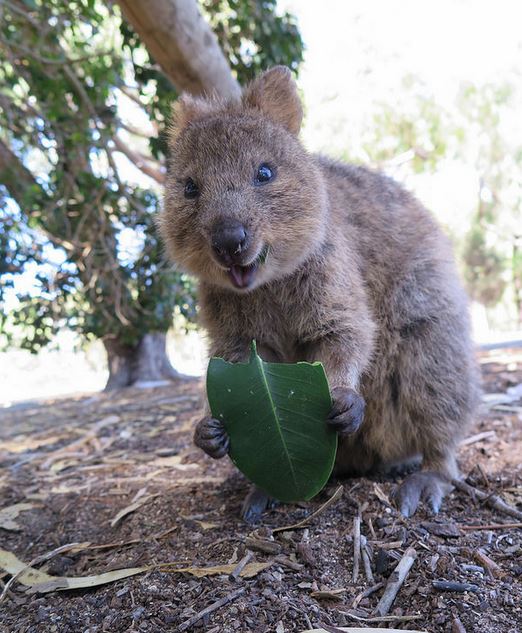
With teddy bear ears and tiny doe eyes, look for the happiest animal on Earth at Rottnest Island in Western Australia.
This small macropod is in the same family as kangaroos and wallabies, with an adorable smile to add even more cuteness.
These nocturnal creatures are about as large as a common house cat and look like a tiny, chubby kangaroo.
They also have a pouch where the baby joey lives in for six months.
When quokkas aren’t eating grasses, shrubs and leaves, they roam around Rottnest Island with the liberty and confidence of a tourist.
With no natural predators or traffic on the island, quokkas have grown accustomed to humans and often make attempts to sneak into restaurants and campsites in search of food.
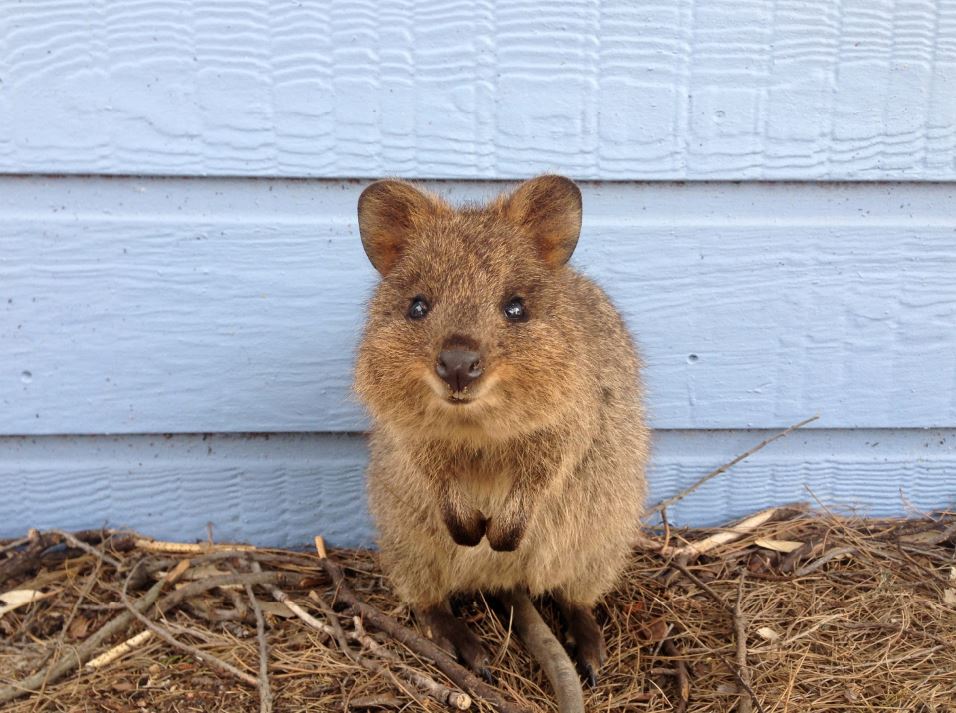
Though it may be tempting to give a quokka a snack, feeding quokkas human food is greatly discouraged.
Attacks are extremely rare, but bites have been reported – usually when people are trying to feed them.
It’s also illegal to touch a quokka – they are wild animals after all – but snapshots and selfies are allowed, even highly sought after.
As naturally inquisitive creatures, they have little fear of humans and will often approach people on their own, sporting a huge picture-perfect smile.
Where to see Quokkas
Your best chance to see quokkas in the wild will be in Rottnest Island, a popular holiday destination off the coast of Western Australia.
This island boasts lovely white sand beaches, stunning coasts and sparkling bays with clear waters perfect for snorkeling.
You’re also very likely to see quokkas in zoos and wildlife parks throughout Australia.
Tree Kangaroo

The tree kangaroo is very much like a shy toddler hiding behind his mother’s leg.
Solitary and elusive, there is still so much to learn about this marsupial.
There are 12 known species of tree kangaroo, all looking quite different from each other.
Some look like a woolly cross between a bear and a kangaroo with golden and red coats. Others have black and dark brown coats with smooth faces.
They typically grow up to 3 feet tall and weigh up to 30 lbs depending on the species.
They dwell among the trees in tropical rainforests of the mountains in Queensland, New Guinea and surrounding islands.
Though “kangaroo” is in their name, these creatures do much better among the trees than on the ground below.
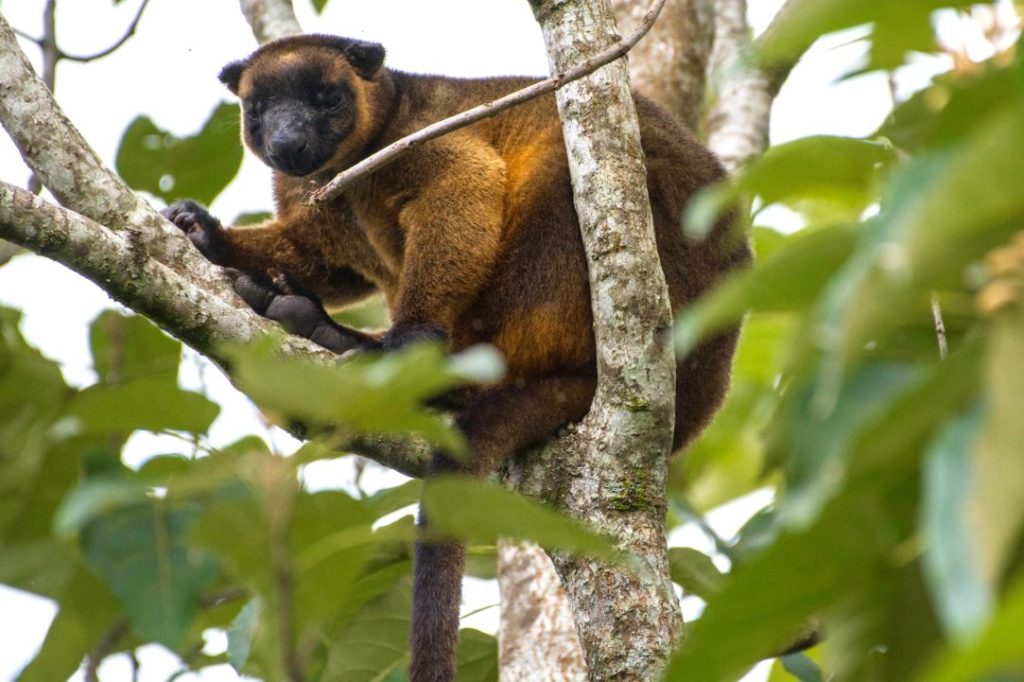
They hop just like kangaroos but rather awkwardly, leaning far forward to balance their long, heavy tail.
They are more bold and agile in trees, hopping across branches with the help of their powerful hind legs and tail.
Tree kangaroos eat mostly fruit, leaves, tree bark and other foliage found in their rainforest habitat.
Its average lifespan is unknown, but in captivity they can live for more than 20 years.
Where to see Tree Kangaroos
The only places you’re sure to see tree kangaroos are in zoos and wildlife parks throughout the state of Queensland.
But if you’re lucky you might see them in the Atherton Tablelands near Cairns.
You might also spot tree kangaroos on the Jungle Surfing tour in Daintree Rainforest!
Platypus
Imagine being the first person to see a playtpus.
Good luck trying to convince anyone that this creature is real!
It doesn’t help that this elusive animal is hard to spot – its silvery brown fur blends within the glistening surfaces of the streams and rivers in its habitat.
The platypus is monotreme, a kind of mammal that lays eggs instead of giving birth to live young.
There are only four other monotremes, the others being different species of echidnas, another animal endemic to Australia.
It’s also one of the few species of venomous mammals in the world.
Males have a spur on their hind legs capable of delivering a venom severely painful to humans, though nothing life-threatening.
These contrary features make it a wonder that the playtpus isn’t an extinct creature from long ago.
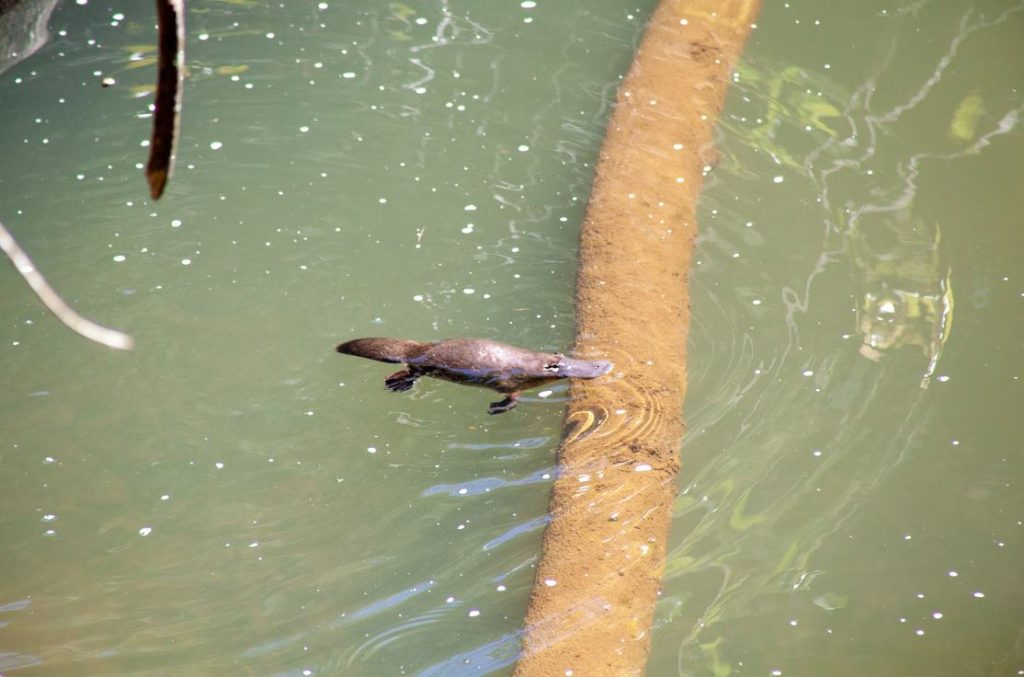
In fact, when scientists first observed a preserved body of a platypus they thought it was fake, made of different animals parts sewn together.
Though the platypus is abundant in the wild, numbers are decreasing, bumping the platypus to a “near threatened” status.
Where to See a Platypus
The platypus is generally found in the riverbanks of Australia’s eastern coast as well as Tasmania.
There are only a few wildlife sanctuaries in Australia that house platypus, including the Lone Pine Koala Sanctuary in Brisbane, Taronga Zoo in Sydney, and Healesville Sanctuary near Melbourne.
A special tank called a platypusary is required for housing a platypus. For this reason there are no playtpus in captivity outside of Australia.
These special tanks allow you to see a platypus up close, where its twists and turns in the water will reveal its playful nature.
Quolls
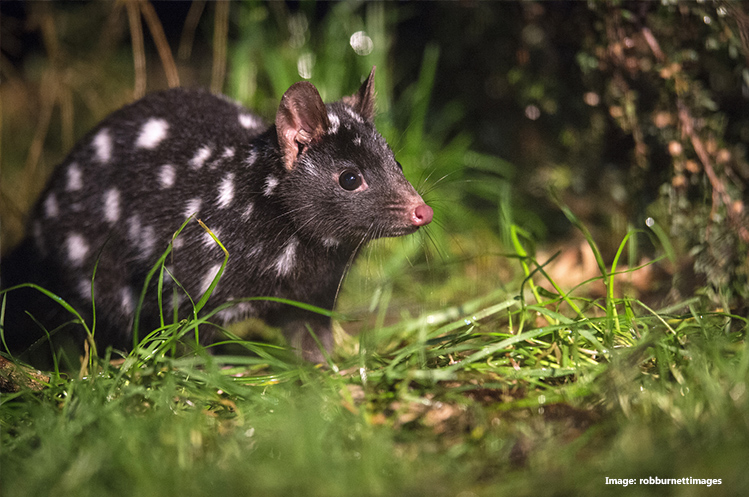
With a stocky body and a long tail, these spunky creatures are much like a cross between a Tasmanian Devil and a cat.
Its white-spotted dark brown coat and dainty pink nose make it look like the star of a cartoon.
But these carnivorous marsupials mean business.
Their sharp teeth delight in munching on birds, reptiles and small mammals such as bandicoots, possums and rabbits.
Mainly nocturnal animals, quolls will sometimes bask in the sunshine, much like Tasmanian devils.
Females also grow a pouch where their young live for the first few months of life.
Like wombats, their pouch opens toward the rear – only the spotted-tail quoll has a true pouch.
Larger quolls live up to four to five years while smaller quolls have a lifespan of about two years.
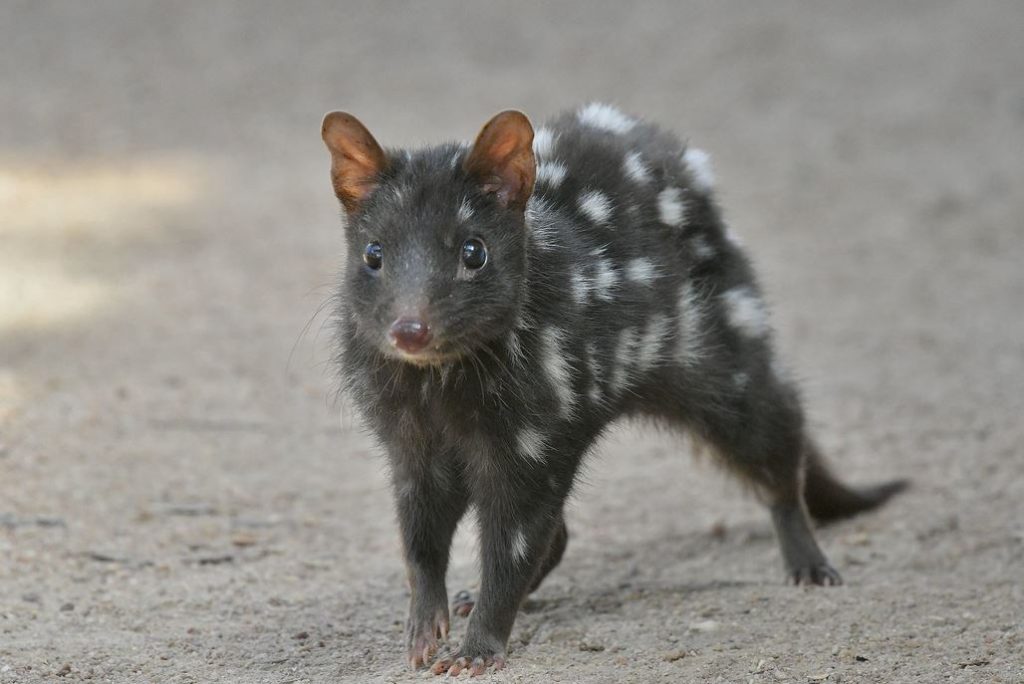
There are four species of quoll native to Australia: the western quoll, eastern quoll, spotted-tail quoll and the northern quoll.
Listed as endangered, major conservation efforts are underway to help preserve quolls and reintroduce some species in the wild.
Recently, conservation efforts have led to the successful birth of rare eastern quolls in the wild for the first time in half a century.
Where to See Quolls
Quolls are native to the eastern coast of Australia while eastern quolls are found only in Tasmania.
You’re not very likely to see them in the wild outside of dedicated nature park refuges, so your best bet is to see them in wildlife parks and zoos.
Lyrebirds
It wouldn’t be surprising at all if lyrebirds are in fact robots in disguise.
With incredible abilities to mimic chainsaws, camera shutters and toy guns, lyrebirds are easily one of Australia’s most impressive birds.
Some reports even swear to hearing lyrebirds mimic human speech.
Lyrebirds, found in the rainforests of Victoria, New South Wales and Queensland, pick up sounds from their surrounding environment.
It’s able to recreate such fantastic sounds through the complex muscles of its syrinx. It takes up to one year for the lyrebird to hone its song, made up of calls from other birds. These vocalizations easily fool other birds, often responding to the lyrebird’s call.
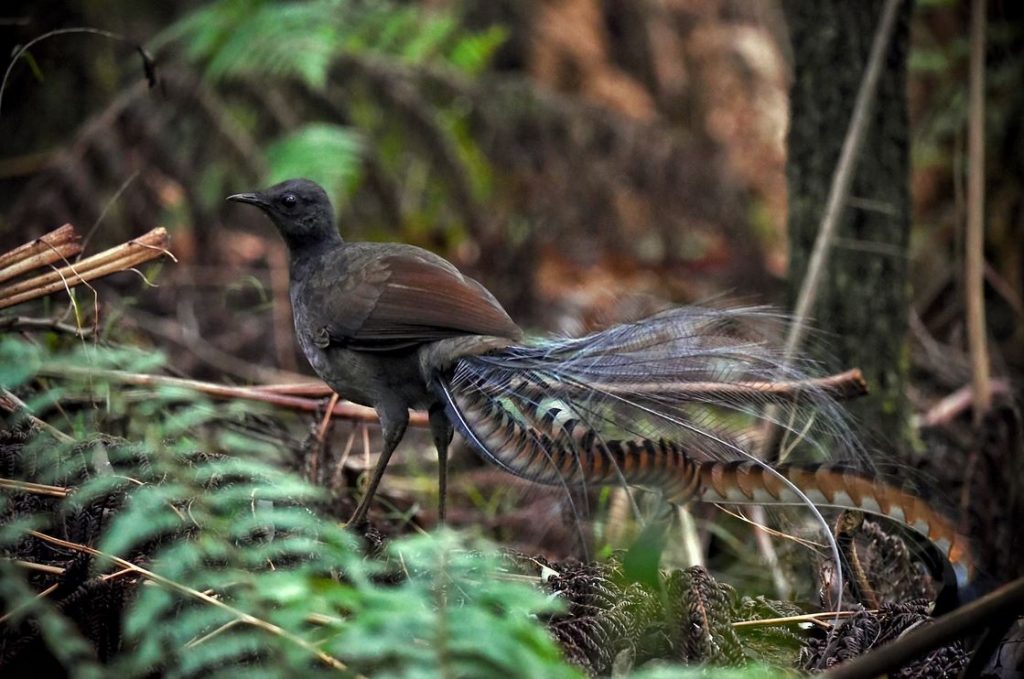
And if such impressive tunes are not enough, male lyrebirds will display their gorgeous lyre-shaped plumes during courtship.
With such charming features, the lyrebird will surely win a mate.
There are two species of lyrebirds: the superb lyrebird and the Albert’s lyrebird, named after Prince Albert.
As ground dwelling birds, they rarely take flight.
Though the status of lyrebirds is “near threatened,” they are currently not an endangered species.
Where to See Lyrebirds
The lyrebirds at Healesville Sanctuary near Melbourne love to show-off their songs to visitors.
Spot wild lyrebirds in the Yarra Valley and Dandenong Ranges, both just an hour away from Melbourne.
Want to See Australia’s Unique Wildlife?
Known for its array of fascinating native wildlife, a trip to Australia isn’t complete without at least petting a koala or kangaroo.
But once you step inside a wildlife park, you’ll discover so many more breathtaking Australian animals you might’ve not known existed.
If seeing Australia’s wildlife is a huge bucket list item for you, we know the best places for unforgettable wildlife experiences.
Phone us Toll Free on 1-888-359-2877 (CT USA, M-F 8.30am – 5pm).You May Also Like
Tags: australia, best places to visit, Kangaroo Island, Melbourne, Places to Visit in Australia, planning, Queensland, Tasmania, Wildlife




